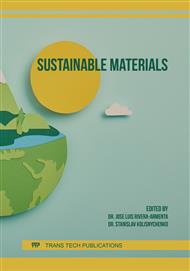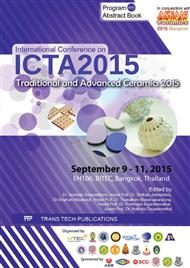p.87
p.92
p.97
p.103
p.109
p.114
p.120
p.126
p.131
Effect of Borax on Lightweight Material from Cullet and Fly Ash
Abstract:
This work investigated the recycling of fly ash waste and cullet as the raw materials for lightweight bodies produced by heat treatment and using sodium silicate as the binder. Borax was mixed with fly ash and cullet, and put into the block in dimension 10x10x2 cm3. The lightweight materials thus produced were then sintered at temperature of 800 °C. Density, compressive strength and thermal conductivity were determined. Borax showed a positive sintering effect on the porosity of lightweight material during the heat process. The compressive strength of lightweight material diminished with the reduction of density and thermal conductivity. Lightweight material manufactured with borax showed the lower density and thermal conductivity accompanied by the higher compressive strength. The test results indicated that using fly ash and cullet as the raw material with borax could obtain the lightweight material, thus enhancing the possibility of its reuse in a sustainable way.
Info:
Periodical:
Pages:
109-113
Citation:
Online since:
May 2016
Keywords:
Price:
Сopyright:
© 2016 Trans Tech Publications Ltd. All Rights Reserved
Share:
Citation:



